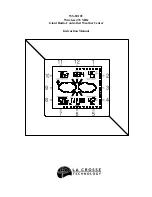
50
building
structure,
the
ground
or
trees).
To calibrate temperature, we recommend a mercury or red spirit (fluid) thermometer. Bi-
metal (dial) and digital thermometers (from other weather stations) are not a good source
and have their own margin of error. Using a local weather station in your area is also a poor
source due to changes in location, timing (airport weather stations are only updated once
per hour) and possible calibration errors (many official weather stations are not properly
installed
and
calibrated).
Place the sensor in a shaded, controlled environment next to the fluid thermometer, and
allow the sensor to stabilize for 48 hours. Compare this temperature to the fluid
thermometer and adjust the ObserverIP receiver to match the fluid thermometer.
(2)
Humidity is a difficult parameter to measure electronically and drifts over time due to
contamination. In addition, location has an adverse affect on humidity readings (installation
over
dirt
vs.
lawn
for
example).
Official stations recalibrate or replace humidity sensors on a yearly basis. Due to
manufacturing tolerances, the humidity is accurate to ± 5%. To improve this accuracy, the
indoor and outdoor humidity can be calibrated using an accurate source, such as a sling
psychrometer.
(3)
The receiver displays two different pressures: absolute (measured) and relative (corrected to
sea-level).
To compare pressure conditions from one location to another, meteorologists correct
pressure to sea-level conditions. Because the air pressure decreases as you rise in altitude,
the sea-level corrected pressure (the pressure your location would be at if located at sea-
level) is generally higher than your measured pressure.
Thus, your absolute pressure may read 28.62 inHg (969 mb) at an altitude of 1000 feet (305
m), but the relative pressure is 30.00 inHg (1016 mb).
The standard sea-level pressure is 29.92 in Hg (1013 mb). This is the average sea-level
pressure around the world. Relative pressure measurements greater than 29.92 inHg (1013
mb) are considered high pressure and relative pressure measurements less than 29.92 inHg
are considered low pressure.
To determine the relative pressure for your location, locate an official reporting station near
you (the internet is the best source for real time barometer conditions, such as Weather.com
or Wunderground.com®), and set your weather station to match the official reporting
station.
Содержание IP Observer WH2600 SE
Страница 1: ...1 WH2600 SE WH2601 SE Benutzerhandbuch Internet Wetterstation ...
Страница 26: ...26 Reference Figure 4 Locate and align the groove on the sensor array and mounting pole Figure 4 ...
Страница 28: ...28 Figure 6 ...
Страница 48: ...48 Figure 22 Figure 30 ...
Страница 56: ...56 Figure 25 ...











































